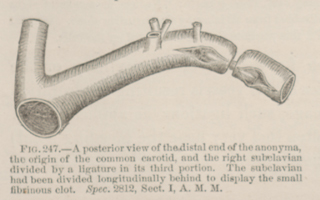Title: B——, Henry
Source text: Surgeon General Joseph K. Barnes, United States Army, The Medical and Surgical History of the War of the Rebellion. (1861–65.), Part 1, Volume 2 (Washington, D.C.: Government Printing Office, 1870), 540.
Civil War Washington ID: med.d1e19811
TEI/XML: med.d1e19811.xml
CASE 10.—Sergeant Henry B——, Co. D, 12th New Hampshire Volunteers, aged 21 years, was admitted to Emory Hospital, Washington, June 11th, 1864, with a gunshot wound of the right shoulder, received at Cold Harbor on the 3d. A minié ball entered below the clavicle and passed out at the anterior aspect of the arm, about three inches below the shoulder joint. He also received a flesh wound of the upper third of the right thigh. The patient had a hæmorrhagic diathesis, which his father stated was hereditary in the family—for example, a simple cut of the finger would cause hæmorrhage to such an amount as to endanger life. Under these circumstances, and upon consultation, it was decided after his first attack of hæmorrhage to ligate the subclavian. The operation was successfully performed on June 17th, by Surgeon N. R. Moseley, U. S. V. Strong hopes were entertained of the patient's recovery; but, unfortunately, in addition to his peculiar diathesis, he had a severe cough, which it seemed almost impossible to relieve or arrest temporarily. On the morning of the 29th, while in conversation, the artery gave way, and death was almost instantaneous from hæmorrhage. The adjacent wood-cut represents the specimen, which was prepared and presented, with the notes of the case, by Surgeon N. R. Moseley, the operator. It consists of a portion of the innominata and of the subclavian and carotid, and is figured in the wood-cut (FIG. 247). There were slight fibrinous exudations on either side of the point at which the ligature cut through. The commencement of the vertebral and superior intercostal are shown, and the thyroid axis and transversus colli.
